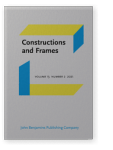Vol. 13:2 (2021) ► pp.193–229
Slovak comparative correlatives
A usage-based construction grammar account
Comparative Correlatives (CCs) are biclausal constructions (e.g. The harder you work, the more you earn) that have complex semantics and form. This is the first construction grammar-based corpus study to investigate Slovak CCs, based on a 500-token sample. I argue that intra-clausal word-order phenomena can be explained through processing efficiency, based on Hawkins’ principle of Early Immediate Constituents (2004), and I use covarying-collexeme analysis (Stefanowitsch & Gries 2005) to provide evidence for the existence of meso-constructions. The findings of this study contribute to construction grammar’s “aspirations toward universal applicability” (Fried 2017: 249), proving that the theory is also suitable for analysis of syntactic patterns in Slavic languages.
Article outline
- 1.Introduction
- 2.The Slovak CC construction
- 3.Corpus study: Results and analysis
- 3.1 filler type
- 3.2 lexical filler
- 3.3 verb presence
- 3.4Comparative element position
- 3.5Covarying collexeme analysis of the data
- 3.5.1Covarying-collexeme analysis of filler types
- 3.5.2Covarying-collexeme analysis of lexical fillers
- 3.5.3Covarying-collexeme analysis of verb presence
- 3.5.4Covarying-collexeme analysis of comparative element position
- 4.Discussion of the results
- 5.Conclusion
- Acknowledgements
- Notes
-
References
